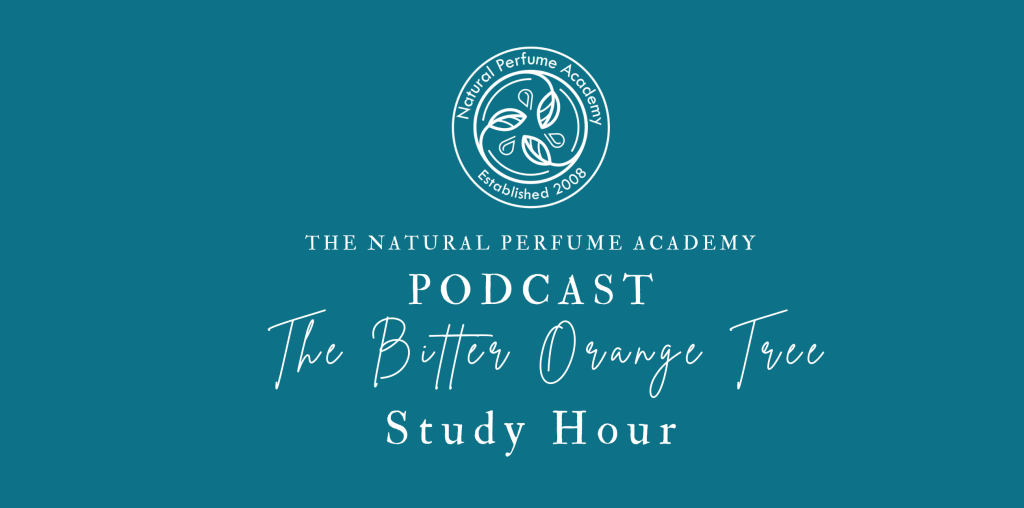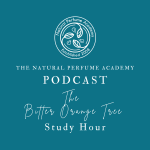
The Bitter Orange Tree: Five Fragrant Treasures in Perfumery

This is a quiet study hour and a special bonus episode—a one-hour reading for anyone who wants to learn and reflect. We welcome recordings of your recording or reading in any language. Please forgive my prononciation of some words.
We explore the aromatic contributions of the bitter orange tree to perfumery, detailing its five distinct fragrant materials and their historical, cultural, and olfactory significance.
Bitter Orange Tree’s Fragrant Gifts
The bitter orange tree produces five distinct aromatic materials that are highly valued in perfumery. These extracts include orange blossom absolute, neroli, orange blossom water absolute, petitgrain, and bitter orange peel oil, each contributing unique scent profiles and uses.
- Orange blossom absolute is a solvent-extracted concentrate known for its deep, narcotic sweetness and floral complexity.
- Neroli oil, distilled from orange blossoms, offers a lighter, brighter scent and is a key ingredient in classic colognes.
- Orange blossom water absolute is a byproduct extract with a sharper, greener floral tone, enhancing realism in blends.
- Petitgrain oil, derived from leaves and twigs, has a bittersweet green-citrus scent and serves as a versatile modifier in perfumery.
- Bitter orange peel oil provides a complex, tart character, often used in classical compositions and known for its phototoxicity.
Orange Blossom Absolute: The Opulent Extract
Orange blossom absolute is a rich extract from the bitter orange’s blossoms, historically captured through enfleurage or maceration. It is celebrated for its warm, honeyed aroma and has been a staple in bridal bouquets and classic perfumes.
- The scent profile includes deep floral sweetness with indolic undertones, often described as more sensual than neroli.
- Historically favored in the Victorian era, it symbolizes purity and love, famously worn by Queen Victoria at her wedding.
- Used in iconic perfumes like Guerlain’s Après L’Ondée and L’Heure Bleue, it enhances both floral and masculine compositions.
- Pairs well with jasmine, tuberose, ylang-ylang, and citrus oils, acting as a fixative in colognes.
Neroli Oil: The Bright Floral Essence
Neroli oil, derived from orange blossoms, is known for its ethereal and uplifting scent, often associated with the Italian Princess of Nerola. It is a key ingredient in classic colognes and modern perfumes, valued for its fresh and clean aroma.
- The scent profile features a sweet-green and spicy top note with a bright citrus facet, lacking the indolic depth of orange blossom absolute.
- Historically significant in Eau de Cologne formulations, it bridges citrus top notes and floral hearts.
- Commonly paired with bergamot, lemon, and green herbal notes, it adds a refreshing lift to various compositions.
- Culturally, neroli is used in folk medicine for its calming properties and has a historical association with purity.
Orange Blossom Water Absolute: A Unique Byproduct
Orange blossom water absolute is a niche extract obtained from the hydrosol left after distilling orange blossoms for neroli oil. It captures the remaining aromatic compounds, offering a distinct scent profile.
- The aroma is described as harsher and greener, with a more astringent floral tone compared to orange blossom absolute.
- It provides an earthy, herbaceous undertone, enhancing realism in orange blossom accords.
- Used as a nuancer in natural perfumery, it can prevent floral compositions from becoming overly sweet.
- Pairs well with petitgrain, bergamot, and light woods, contributing to a fresh floral lift.
Petitgrain Oil: The Green Citrus Modifier
Petitgrain oil is extracted from the leaves and twigs of the bitter orange tree, known for its bright, bittersweet green-citrus scent. It serves as a versatile ingredient in various perfume compositions.
- The scent profile includes a floral undertone with a sharp green and spicy-citrus punch, softening into a sweet floral heart.
- Historically used in citrus colognes and fougères, it helps bridge citrus top notes and floral heart notes.
- Commonly paired with bergamot, lemon, and herbal notes, adds complexity and longevity to fragrances.
- Petitgrain is recognized for its calming properties and is often considered a cost-effective alternative to neroli.
Bitter Orange Peel Oil: The Complex Citrus Note
Bitter orange peel oil is derived from the peels of bitter oranges, offering a complex, tart character that enhances classical compositions. It is valued for its unique scent profile and versatility in perfumery.
- The aroma combines elements of sweet orange, bergamot, and grapefruit, with a distinctive bitter, dry undertone.
- Used as a bright top note in colognes and chypres, it adds sophistication and prevents compositions from being overly sweet.
- Pairs exceptionally well with neroli and petitgrain, creating a comprehensive representation of the orange tree.
- Caution is advised due to phototoxicity; many modern oils are available in furocoumarin-free versions.
The Unique Olfactory Aspects of Bitter Orange
The bitter orange tree offers a diverse range of scents from its various parts, each contributing to a complex olfactory experience. Perfumers have long been inspired to blend these elements to create harmonious fragrances that evoke the essence of the entire tree in bloom.
- Bitter orange tree components include:
- Blossom absolute: deep gold and honeyed
- Neroli: bright white and green
- Water absolute: earthen and pale green
- Petitgrain: vibrant chartreuse
- Bitter orange oil: vivid orange and yellow
- Blending these materials creates a “symphony” of scents.
- Modern reviewers appreciate the harmonious mingling of these notes.
Balancing the Orange Tree Accord
Creating a balanced perfume using bitter orange components requires skill and understanding of each material’s strength. Proper proportions ensure that no single note overwhelms the blend, resulting in a well-rounded fragrance.
- Orange blossom absolute is potent and should be used sparingly (around 5%).
- Neroli and petitgrain can be used more liberally due to their lighter nature.
- Bitter orange oil can dominate if used in excess; it should be a top note.
- A well-balanced blend prevents heaviness or cloying sweetness.
Historical and Traditional Pairings in Perfumery
Classic perfumes have historically combined various orange tree essences to achieve refreshing and full-bodied profiles. These traditional pairings illustrate the versatility and appeal of orange floral notes in fragrance.
- Piesse’s cologne included neroli petale, neroli bigarade, orange peel, and petitgrain.
- Hungary Water originally heavy on rosemary later incorporated orange blossom for improved aroma.
- Vintage floral perfumes often use neroli for brightness and orange blossom absolute for depth.
Modern Natural Perfumery Trends
Natural perfumers today aim to capture the essence of the entire orange tree using its various components. This approach emphasizes the synergy between the materials, enhancing the overall fragrance experience.
- Hiram Green’s Dilettante (2016) combines orange blossom absolute, petitgrain, and bitter orange oil.
- Reviews highlight how these materials elevate each other, creating a rich, intoxicating scent.
- Parfums de Nicolaï’s Neroli Intense is noted for capturing the “whole orange tree for summer.”
Creative Use of Contrast in Fragrance
While harmonizing scents is essential, contrasting elements can also create interesting and unique fragrances. This technique can enhance the overall complexity and depth of a perfume.
- Pairing earthy orange flower water absolute with sweet orange blossom absolute creates textural contrast.
- Bitter orange oil can be effectively contrasted with gourmand notes like vanilla to add elegance.
- Care must be taken to ensure green bitterness does not overpower floral notes.
Practical Formulation Example for Orange Tree Accord
A suggested formulation for an “Orange Tree accord” illustrates how to blend the various components effectively. This conceptual ratio aims to create a balanced and harmonious fragrance.
- Suggested ratios:
- Neroli: 30%
- Petitgrain: 25%
- Bitter Orange peel oil: 20%
- Orange Blossom Absolute: 5%
- Orange Flower Water Absolute: 5%
- Other notes: 15% (optional)
- The blend should evoke the scent of a blooming bitter orange tree, capturing citrus, blossoms, leaves, and bark.
The Poetic Nature of the Bitter Orange Tree
The bitter orange tree symbolizes fertility, love, longevity, and renewal, making it a rich source of inspiration for perfumers. Capturing all parts of the tree in a fragrance creates a complete olfactory portrait of its life cycle.
- The tree offers a complete perfumer’s palette, emphasising creativity and sustainability.
- Each part of the tree contributes unique aromatic qualities, preventing redundancy in blends.
- The combination of scents creates a fuller spectrum, akin to a musical chord.